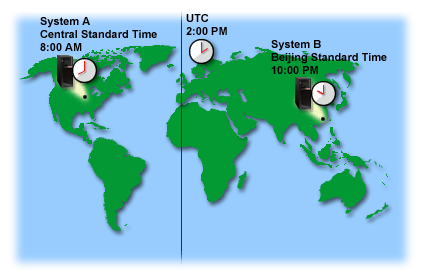Time
Time on a system involves several time concepts, such as time zones, Coordinated Universal Time (UTC), system time, and job time. Each system or partition uses system time. System time is displayed through the time of day system value.
System time is one important time concept. However, you need to understand the various time concepts that play an important role in time management. The following concepts are important concepts that relate to time:
- Local system time (system time)
- Local system time is determined by applying the system's time zone offset and year offset values to UTC. The Time of day system value displays the local system time. Local system time and system time are used interchangeably.
- Local job time
- Local job time is determined by applying the job's time zone offset and year offset values to UTC. To view a job's local date and time, view the Date/Time page of the job's properties.
- Coordinated Universal Time
- Coordinated Universal Time is used to calculate local system time and job time. The offset from UTC and the year offset values are applied to UTC time to calculate the local system time (system time).
- Offset from Coordinated Universal Time
- Offset from Coordinated Universal Time represents the difference in hours and minutes between UTC and the local system time. A negative offset indicates that the time is west of UTC and a positive offset indicates that the time is east of UTC.
- Year offset
- Year offset indicates the difference in years between the current Gregorian year and the current year in the calendar used with the time zone for your system.
- Daylight saving time
- Daylight saving time (DST) is the portion of the year in which the local time of a region is advanced from the standard official time of the region.
- Daylight saving time shift
- Daylight saving time shift represents the number of minutes that local time moves forward when DST starts, or the number of minutes that local time moves backward when DST ends.
- Time zone
- The time zone settings specify the offset from UTC and whether to observe DST. Each logical partition on a system can specify a time zone to use.
To combine these time concepts into the various time values associated with a system, examine two systems that use different time zones.

This figure shows two systems in two different time zones. System A is in the Central Standard Time zone and System B is in the Beijing Standard Time zone.
Each system's time values are as follows:
| System A | System B | |
|---|---|---|
| Local system time | 8:00 a.m. | 10:00 p.m. |
| Local job time | 8:00 a.m. | 10:00 p.m. |
| Time zone | Central Standard Time | Beijing Standard Time |
| Offset from UTC | -6:00 | +8:00 |
| UTC | 2:00 p.m. | 2:00 p.m. |